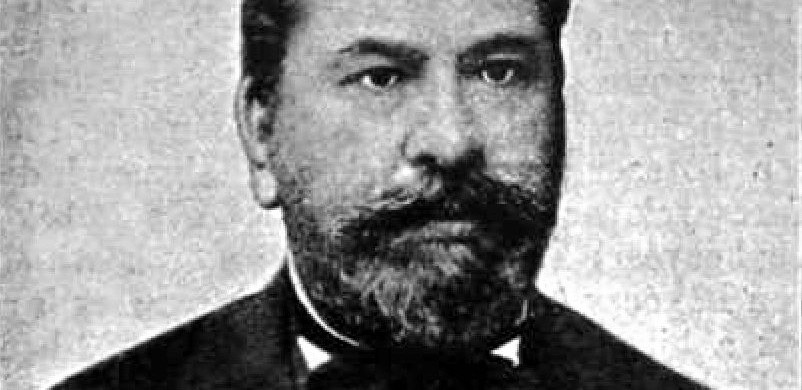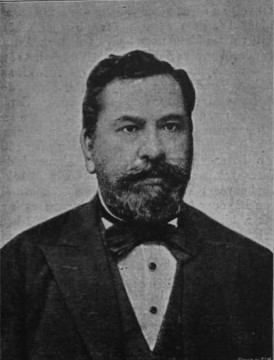Ferdinand Barna 1871
Ferdinánd Barna (1825-1895), a clerk at the Hungarian National Museum, began to study the Finnish language and especially Kalevala around 1863. His only aids to the study of Finnish were I. Fabian’s Grammar (1859) and Hunfalvy’s Finnish Reader (1861), and the first part of Renvall’s Latin-Finnish Dictionary. Through Hunfalvy’s encyclopaedia, Barna was introduced to the Kalevala and became enthusiastic about translating it. Professor Ferenc Toldy saw Barna’s manuscript by chance and encouraged him to continue the translation. Thus began years of painstaking work.
When the Hungarian translation was more or less finished in 1865, the translator wrote to August Ahlqvist with his poor Finnish, asking him to explain certain verses of the Kalevala that had remained unclear to him. Ahlqvist replied very helpfully and thoroughly on 24 August, and Barna rushed to reply as early as 14 September (his Finnish, again, quite endearingly shaky):
”Sydämellisiä kiitoksia sen suosion tähden että Te kirjoitamassani sysältäväin kysymyksiin vastata ja ne tarpeelliset minullen hyvä tahtoisesti antaa suonut olitte. – Teidän selityksissä olen minä hyvän hyödytyksen ottanut, sillä niiden avulla osasin minä kaiket minun käännöksessäni löytättävät vaajavat paikat täydelliseksi panna, onpa nyt jo koko teos valmis.”
After the last corrections, the complete Hungarian translation of the Kalevala was published in 1871 by the Hungarian Academy of Sciences. “This work”, wrote the Kirjallinen Kuukauslehti 1872 pp. 30-34, “rivals the Finnish edition, which is usually called ‘the magnificent edition’, for its hefty appearance. “The metre seems to be the same as in the Finnish poems, with the only difference that instead of the initial alliteration, the rhyme is often used. A number of explanations are appended to the end of the work. But what deserves most scrutiny on our part is the translator’s preface, which draws a few comparisons between the ancient Finnish poems and the oldest ancient Magyar poems.’ This is followed by about six columns of the Hungarian translation of the preface.
In the 1909 issue of the Valvoja (p. 282), E. N. Setälä described Barna’s work: ‘[His] main principle was that the translation should be as accurate as possible. He tried to make Hungarian to conform to the Finnish sentence structure. As a result, the translation was not very enjoyable, especially as Barna was not a poet.” In his foreword, Barna himself mentions that he tried to use etymologically equivalent words to Finnish, if their meaning allowed, but the Finnishisation of the sentence structure is only found in exceptional cases, by mistake, and even then the translator corrects the error. If the vocabulary or sentence structure differs from the 1860s written language, it is because the translator occasionally uses dialect words and archaic forms.
According to Béla Vikár, the author of the new, better Kalevala translation, the famous Hungarian linguist J. Budenz once said that the translation of Barna was “Barnevala” rather than Kalevala. The play on words can give a false impression of the translation work of Barna, so it is useful to give a few verses about the work of both translators:
| Kalevala 23: 364– | Barnan käännös (1871): | Vikárin käännös (1909): |
| Jo on sauna joutununna,
vee’et ve’etty, vastat saatu, kaikki lautaset la’aistu; — Itse lienen löylyn lyöjä, alla lautojen asunen. |
Rád a fürdő már készen vár,
vizet hordtam, vesszőt vittem, Minden pallót letöröltem, (aik.: polcot) — A gőzöt majd magam verem. Deszkák alatt ügyeskedem. |
Fülik már a finom fürdő,
víz vedelve, seprő pállva, polczok simára sikálva, — Én várlak a vesszőcskével, polczok alatt poszton állok. |
Vikár’s translation is undoubtedly smoother and more beautiful as a poem, but it contains inaccuracies. Barna’s translation of the Kalevala was not a brilliant work of poetry, but it fulfilled the honourable function of representing Finnish literature at a time when the Finnish-Hungarian theory of kinship was under attack in Hungary. The Hungarian Kalevala translation had so many readers that it sold out in 20 years.
Barna was never able to visit Finland, but nevertheless he “considered it his life-long and dear task to build the spiritual bridge whose foundation, not without disadvantages, is now happily and unswervingly laid, and whose purpose must be to bring about mutual cooperation between the Hungarian and Finnish tribal peoples and to bring the two peoples closer to each other…”
In recognition of his interest in Finland, which was still rare at the time, Barna was elected a correspondent member of the Finnish Literary Society (1872) and an external member of the Finno-Ugric Society (1884).
This early Hungarian-Finnish cooperation and interest gradually developed into Finno-Ugric cultural congresses and other co-operation.
Gyula Weöres:”Ferdinánd Barna, Kalevalan unkarintaja” – Kalevalaseuran vuosikirja 42. Helsinki: WSOY. 1962.

